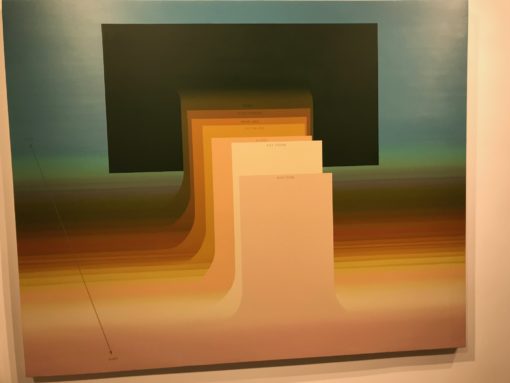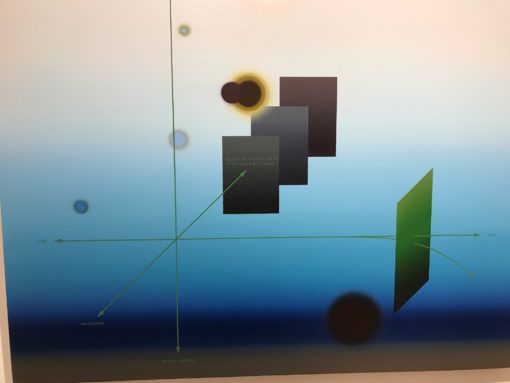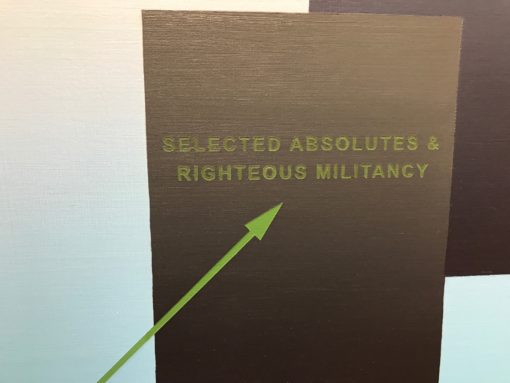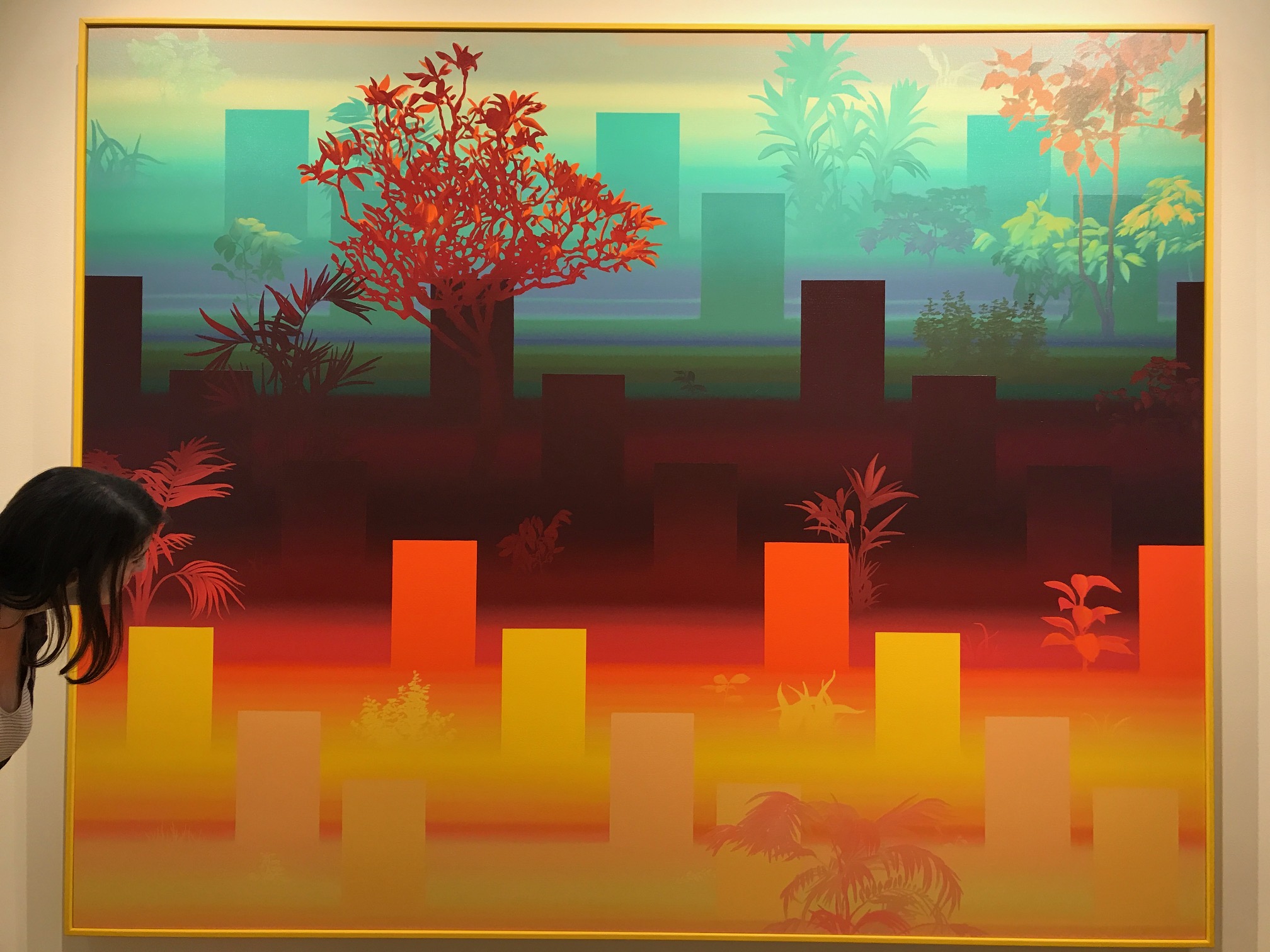Even before pie charts and bar graphs, before we’re plotting curves and breaking down conic sections in algebra and analytic geometry, we become accustomed to the graphic visual representation of every kind of trend, concept, and systematized data or information. It almost goes hand in hand with the way we structure ideas, systems, and organizations. The visual concepts become part and parcel of the systems and ideas they express. They become integral to the way we extrapolate, track progress, draw conclusions, predict outcomes.
There’s a certain kind of idealism built into this kind of visual grammar. It’s particularly recognizable in the kinds of financial and management data we see presented in annual reports or equity offerings of corporations and banks or financial institutions. Even relatively sobering information and statistics can be packaged with sufficient coolness and elegance to compartmentalize very rational concerns and anxieties, encouraging us to push forward (or past what might be potentially disturbing) to that place where we resolve to carry on, finish the work, complete the project, renew the pledge (preferably in hard currency), and secure the investment.
 Nicolas Grenier is a particularly sophisticated observer of this kind of visual presentation – and the larger cultural narrative it drives, however abstractly. The abstraction of course is an essential part of it. There’s a kind of value system embedded in this language. He also understands its nexus with an implicitly surreal, even utopian (meaning entirely confabulated) domain of projected reality.
Nicolas Grenier is a particularly sophisticated observer of this kind of visual presentation – and the larger cultural narrative it drives, however abstractly. The abstraction of course is an essential part of it. There’s a kind of value system embedded in this language. He also understands its nexus with an implicitly surreal, even utopian (meaning entirely confabulated) domain of projected reality.
There was a whole lot of projection going on at Luis De Jesus Los Angeles Saturday evening, where Grenier opened his second show for the gallery, Dumbfounded Prophets. Personally I might have tried spinning the title out along one of the tangents suggested by the other-worldly atmospherics that immersed these graphic projections – say, ‘Dumbfounded prophets, and the curve in the universe where their prophesies tracked off-course into another dimension, where they were sucked into a dark star releasing a chaotic cocktail of comets composed of lethal radiation and negative ions’ (in short, a fallout both benign and malign).
 Grenier has a way of dissolving that radiation into his palette, modulating atmospherics from a kind of neon-infused magenta into the kind of sapphire indigo we’d expect to see on the other side of a dark star. There’s a continuity, too, between these elusive, elliptical quants pitched somewhere between the serendipitous and sardonic and the kind of horizontally oriented chart that elides into a kind of landscape – or dreamscape. In one painting, a multiple track of syncopated bar graphs float or sink in sedimentary layers that might carry their own narrative burden, whether ‘quantitative’ or ‘qualitative’ (or both? – by way of the light spectrum?) – an image further complicated by foliage seemingly burned into an irradiated subterranean level, reemergent in a deep aubergine-brown patch in the painting’s midsection; and in glorious magenta bloom against the backdrop of an aquamarine world either drowning or evaporating, yet no less luminous than the painting’s glowing lower section.
Grenier has a way of dissolving that radiation into his palette, modulating atmospherics from a kind of neon-infused magenta into the kind of sapphire indigo we’d expect to see on the other side of a dark star. There’s a continuity, too, between these elusive, elliptical quants pitched somewhere between the serendipitous and sardonic and the kind of horizontally oriented chart that elides into a kind of landscape – or dreamscape. In one painting, a multiple track of syncopated bar graphs float or sink in sedimentary layers that might carry their own narrative burden, whether ‘quantitative’ or ‘qualitative’ (or both? – by way of the light spectrum?) – an image further complicated by foliage seemingly burned into an irradiated subterranean level, reemergent in a deep aubergine-brown patch in the painting’s midsection; and in glorious magenta bloom against the backdrop of an aquamarine world either drowning or evaporating, yet no less luminous than the painting’s glowing lower section.
I’m not doing justice to Grenier’s palette here, which can range from a baseline of plush neutrals to the richer spectrum that goes from middle-earth muddy to metallic, from jewel-tone brilliants to the neon-charged and ultimately a radiant domain from unearthly to, well, ineffable. Whether or not that’s a word that can legitimately describe a color range, I think it can be said that Grenier is an artist at ease with the ineffable. His stylistic range is no less supple, pitched somewhere between Kandinsky and Yves Tanguy. I’m exaggerating, but if those two art-gods had cleared a few cultural hurdles – say, lysergic acid and Photoshop – and survived into the digital age, Grenier would have made a fine artistic godchild. Grenier takes the stuff of private equity projections and hedge fund algorithms and spins razor sharp tales from their inverted and imaginary axial universe with a satirist’s sensibility and an astronomer’s graceful exactitude.
 The dreamscape of these projections inevitably take us to a philosophically (and perhaps materially) challenged place. The goals (not ideals – this is the oh-so-pretty post-dream disillusionment) are ambitious, if a little sketchy: e.g., “Selected Absolutes and Righteous Militancy” (an eclipse floating over the panel makes for a dubious celestial portent) on the forward side of the ‘z’ axis. Ambition gives way to cynicism at the negative end of that axis (so close to the ‘brown ground’ at the ordinal zero degree) – as in, “Whatever.”
The dreamscape of these projections inevitably take us to a philosophically (and perhaps materially) challenged place. The goals (not ideals – this is the oh-so-pretty post-dream disillusionment) are ambitious, if a little sketchy: e.g., “Selected Absolutes and Righteous Militancy” (an eclipse floating over the panel makes for a dubious celestial portent) on the forward side of the ‘z’ axis. Ambition gives way to cynicism at the negative end of that axis (so close to the ‘brown ground’ at the ordinal zero degree) – as in, “Whatever.”
Grenier seems to understand that the roots of these conditions are deep-seated – a product of the inevitable collision of a cultural conditioning hard-wired to an optimistic notion of no-problem-too-hard-to-solve progress and the cultural actualities that point to irrevocable planetary catastrophe. It’s a conditioning some of us have endured since the middle of the last century. One suite of paintings present several variations on inverted arrays of linear projections that resemble sputniks – the (at that time) Soviet Union’s first competitive shot across the aeronautics/galactic space exploration bow. Another ‘graph’ or ‘projection’ assumes contours that vaguely resemble a drone. Grenier’s art plots attitude adjustment and accommodation on a cosmic scale.
But Grenier’s sophisticated understanding of the vernacular(s) comes right down to the street level and a larger urban experience that translates not merely to three dimensions, but architecture – though Grenier has chosen to render this urban/architectural interface for the challenging, dystopian future-already-here in a film – a dramatic graphic animation, with a chillingly clinical narration. I won’t spoil it for anyone – I walked into the screening room a bit less than half-way into it and missed a good chunk of it – but bleak has never seemed so transcendent, or at least transfigured. Grenier has a way with the soft fade-to-cloudy white. John Carpenter might have called it The Fog; in the Grenier cloudscape, we might call them ‘Evaporated Infinities.’


